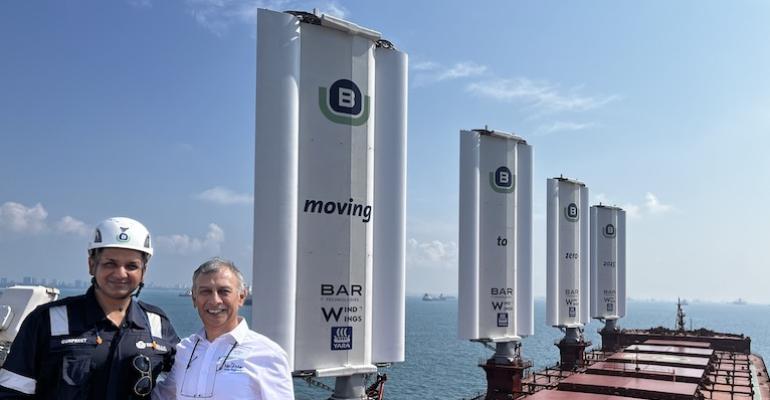Berge Olympus could be the catalyst for a new low or zero carbon maritime alternative with WindWings having fitted four of its rigs to the 211,153 dwt Newcastlemax bulk carrier, which the company says will save up to 20% in fuel consumption and the consequential emissions. WindWings are designed and built by BAR Technologies and Yara Marine Technologies.
Berge Olympus is expected to be only the first step in wind power, which could see a transition, which is now gathering pace with new regulations and the increasing costs of conventionally powered vessels, while the overall costs of alternative fuels, such as ammonia, methanol and hydrogen, remains very high.
Speaking about the Berge Olympus Cameron Mitchell, Isle of Man Ship Registry Director, said: “The project also highlights that there are clear opportunities for vessel owners to swiftly retrofit new technologies to make a rapid and profound difference to the climate impact of their fleet.”
Another player in the market is Windships with a triple foil rig design. Impetus has been gained through the introduction of the EU Emissions Trading System (EU ETS), according to Simon Rogers, the America’s Cup sailboat designer who has designed the triple foil rig for Windships.
According to Rogers Windships is now in discussions with a Greek owner and a Danish consortium of three owners to retrofit the Windship triple foil to bulk carriers and tankers of around 82,000 dwt.
“The EU ETS has reduced the ROI (return on investment) period for a Windship rig to three years, if the carbon price is set at 50% and at 100% that is reduced to just 18 months with a single 36 metre retrofitted triple rig,” said Rogers.
Effectively Windship took the Energy Efficiency of Existing ships Index (EEXI) of a group D vessel which will be required to apply engine power limitation (EPL) for that vessel to keep trading, that will extend the operational life of that asset to two years.
Rogers, an engineer by trade, asks, “What is compliance [with new carbon regulations] worth?” The maximum EPL available will be 40% saving, for a traditional two-stroke marine diesel, that will extend the vessel’s life by two-three years.
“One rig on a Kamsarmax, as a rule of thumb can nominally extend the life of the same type of vessel by six years for an average installed cost of $4.5 million,” explained Rogers.
He also confirmed that the calculations will differ depending on the trades in which sailing vessels operate in, “trading in the North Atlantic will save more than trading in equatorial waters,” admitted Rogers, with the higher latitudes giving better savings generally.
Windships business plan is for the Greek and Danish investors to make the initial investment that will launch the business making subsequent vessel retrofits cheaper as production is ramped up.
“We have a two-year programme to get going, we can get a ship on the water with a retrofitted triple foil rig by 2026 with the first nine ships planned to be ordered in the near future,” claimed Rogers.
Once the technology is proven on the retrofitted ships Rogers expects newbuild orders will come because the installation costs for three triple foil rigs on a new vessel are minimal, and with the Windship design of diesel electric power with other energy saving devices, a new sail ship’s savings would amount to more than 80%, depending on trading patterns.
Sail has been relaunched with the Berge Olympus, but for modern sailing ships the sky’s the limit for their introduction into what will be a highly competitive market sector.
Copyright © 2024. All rights reserved. Seatrade, a trading name of Informa Markets (UK) Limited.
Add Seatrade Maritime News to your Google News feed.  |

